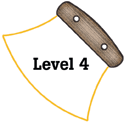
Alaska Science
Key Element A10
 |
Alaska Science |
|
Performance Standard Level 4, Ages 15–18
|
|
|
|
Sample Assessment Ideas
|
|
|
Expanded Sample Assessment Idea
|
|
Procedure Students will:
Reflection and Revision
|
Levels of Performance |
||
|
Stage 4 |
Student work clearly and accurately explains how cell, tissue, and organ level adaptations help an organism survive in its environment. The structure-function relationship of specialized cells, tissues, and organs are each described in detail. | ||
|
Stage 3
|
Student work accurately explains how cell, tissue, and organ level adaptations help an organism survive in is environment. Some structure-function relationships of specialized cells, tissues, and organs are described. | ||
|
Stage 2
|
Student work attempts to describe cells, tissues, or organs in one or more organisms but descriptions of structure-function relationships are incomplete, incorrect, and may contain errors of science fact and reasoning. | ||
|
Stage 1
|
Student work is largely incomplete, incorrect, and contain errors of science fact and reasoning. | ||
Standards Cross-References
|
||
|
National Science Education Standards Cells have particular structures that underlie their functions. Every cell is surrounded by a membrane that separates it from the outside world. Inside the cell is a concentrated mixture of thousands of different molecules which form a variety of specialized structures that carry out such cell functions as energy production, transport of molecules, waste disposal, synthesis of new molecules, and the storage of genetic material. (Page 184) Most cell functions involve chemical reactions. Food molecules taken into cells react to provide the chemical constituents needed to synthesize other molecules. Both breakdown and synthesis are made possible by a large set of protein catalysts, called enzymes. The breakdown of some of the food molecules enables the cell to store energy in specific chemicals that are used to carry out the many functions of the cell. (Page 184) Cells store and use information to guide their functions. The genetic information stored in DNA is used to direct the synthesis of the thousands of proteins that each cell requires. (Page 184) Cell functions are regulated. Regulation occurs both through changes in the activity of the functions performed by proteins and through the selective expression of individual genes. This regulation allows cells to respond to their environment and to control and coordinate cell growth and division. (Page 184) Plant cells contain chloroplasts, the site of photosynthesis. Plants and many microorganisms use solar energy to combine molecules of carbon dioxide and water into complex, energy rich organic compounds and release oxygen to the environment. This process of photosynthesis provides a vital connection between the sun and the energy needs of living systems. (Page 184) Cells can differentiate, and complex multicellular organisms are formed as a highly organized arrangement of differentiated cells. In the development of these multicellular organisms, the progeny from a single cell form an embryo in which the cells multiply and differentiate to form the many specialized cells, tissues, and organs that comprise the final organism. This differentiation is regulated through the expression of different genes. (Page 184) Multicellular animals have nervous systems that generate behavior. Nervous systems are formed from specialized cells that conduct signals rapidly through the long cell extensions that make up nerves. The nerve cells communicate with each other by secreting specific excitatory and inhibitory molecules. In sense organs, specialized cells detect light, sound, and specific chemicals and enable animals to monitor what is going on in the world around them. (Page 187) |
Benchmarks Every cell is covered by a membrane that controls what can enter and leave the cell. In all but quite primitive cells, a complex network of proteins provides organization and shape and, for animal cells, movement. (Page 113) Within the cell are specialized parts for the transport of materials, energy capture and release, protein building, waste disposal, information feedback, and even movement. In addition to these basic cellular functions common to all cells, most cells in multicellular organisms perform some special functions that others do not. (Page 113) The work of the cell is carried out by the many different types of molecules it assembles, mostly proteins. Protein molecules are long, usually folded chains made from 20 different kinds of amino-acid molecules. The function of each protein molecule depends on its specific sequence of amino acids and the shape the chain takes is a consequence of attractions between the chain’s parts. (Page 114) The genetic information encoded in DNA molecules provides instructions for assembling protein molecules. The code used is virtually the same for all life forms. Before a cell divides, the instructions are duplicated so that each of the two new cells gets all the necessary information for carrying on. (Page 114) Complex interactions among the different kinds of molecules in the cell cause distinct cycles of activities, such as growth and division. Cell behavior can also be affected by molecules from other parts of the organism or even other organisms. (Page 114) Gene mutation in a cell can result in uncontrolled cell division called cancer. Exposure of cells to certain chemicals and radiation increases mutations and thus increases the chance of cancer. (Page 114) Most cells function best within a narrow range of temperature and acidity. At very low temperatures, reaction rates are too slow. High temperatures and/or extremes of acidity can irreversibly change the structure of most protein molecules. Even small changes in acidity can alter the molecules and how they interact. Both single cells and multicellular organisms have molecules that help to keep the cell’s acidity within a narrow range. (Page 114) A living cell is composed of a small number of chemical elements, mainly carbon, hydrogen, nitrogen, oxygen, phosphorous, and sulfur. Carbon atoms can easily bond to several other carbon atoms in chains and rings to form large and complex molecules. (Page 114) |
|
Table of Contents | Return to Alaska Native Knowledge Network